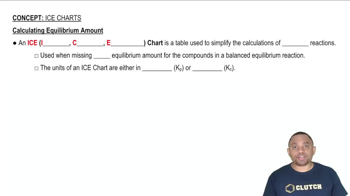Here are the essential concepts you must grasp in order to answer the question correctly.
Equilibrium Constant (Kc)
The equilibrium constant, Kc, quantifies the ratio of the concentrations of products to reactants at equilibrium for a reversible reaction at a given temperature. For the reaction NO(g) + NO2(g) ⇌ N2O3(g), Kc = [N2O3]/([NO][NO2]). A Kc value greater than 1 indicates that products are favored at equilibrium, while a value less than 1 suggests reactants are favored.
Recommended video:
Equilibrium Constant Expressions
Partial Pressure
Partial pressure is the pressure exerted by a single component of a gas mixture. According to Dalton's Law, the total pressure of a gas mixture is the sum of the partial pressures of its individual gases. In this problem, the initial total pressure and the number of moles of each gas will help determine their respective partial pressures at equilibrium.
Recommended video:
Partial Pressure Calculation
ICE Table (Initial, Change, Equilibrium)
An ICE table is a tool used to organize the initial concentrations (or pressures), the changes that occur as the system reaches equilibrium, and the equilibrium concentrations (or pressures) of the reactants and products. By setting up an ICE table for the given reaction, one can systematically calculate the equilibrium partial pressures of NO, NO2, and N2O3 based on the initial conditions and the stoichiometry of the reaction.
Recommended video:
ICE Charts and Equilibrium Amount
 Verified step by step guidance
Verified step by step guidance

